How to conduct a competitor analysis and create a new template for success

Want to know how you can become a more successful business?
Sometimes, incredible companies emerge from an in-depth understanding of their own organisation. After all, it’s hard to excel as a business if you don’t understand your core values, goals, and ambitions. However, sometimes, upgrading your company starts with understanding your competitors. In this article we’ll explain how to conduct a competitor analysis, and provide a template for success.
For most modern businesses, a competitor analysis represents a crucial part of the company marketing plan. With this kind of evaluation in place, you can develop a thorough understanding of the things that make your service and product unique, and therefore, come to terms with the aspects you should highlight to attract your target market.
At Fabrik, our definition of competitor analysis is split between several clearly defined activities, designed to improve the performance of your brand. For instance, we might examine the activities of competing businesses: the messaging they use, their logo, and their visual identity. The advent of the internet has made it easier than ever for people to gather valuable data insights into competing companies.
The depth of your competitor analysis strategy will depend on the scope of what you want to achieve as a business. Many companies approach us with their own competitive intelligence, and we can tap into it to help them maximise their business performance. We can even conduct competitor audits that help you to improve the position of your company in relation to other people within your industry.
Here, we’re going to delve deep into the world of competitor analysis, and provide you with a comprehensive insight of what competitive analysis really means, the tools and templates you can use, and even some examples of questions you might need to ask to get you started.
Let’s begin.
Competitor analysis definition: What is competitor analysis?
Before we can show you not only the value of competitor analysis, but how you can use it to improve your business structure, we need to offer some kind of competitor analysis definition.
A lot of people assume that competitor analysis is all about looking into the marketing strategies of other businesses and searching for simple ways that you can steal their ideas to make money. However, that’s not actually the case.
In simple terms, competitor analysis is a process that involves defining your competitors, gathering information about them, and using that information to supplement your own strategies for success.
Too often, a true competitor analysis definition is distilled down into the early days of research completed before a product launch, or a quick scan over social media accounts to check for potential mentions. This lax approach to competitor analysis has meant that many businesses simply aren’t taking advantage of the results that competitor audits can offer.
With a good competitor analysis, you can learn how the biggest threats in your industries are positioning their brand, and you can also discover which spaces are left open for you to take advantage of.
The competitor analysis definition: Identifying the threat
The first step in conducting a competitor analysis, or audit, is to figure out who your current competitors actually are. You need to know not only who poses a threat to you right now, but also who could potentially be a threat later.
There are two ways to begin your competitor analysis definition. These include:
- Looking at things from your competitor’s point of view.
- Looking at things from a customer’s point of view.
If you examine your competitors from the perspective of their target customer, then you’ll be looking for flaws and weaknesses. In other words, you’ll be placing yourself in the shoes of a consumer, and trying to think as they would. For instance, you might ask yourself why a customer would choose the competitor’s services over yours, what makes them different to you, and how you could change to make yourself more appealing to the same demographic.
Alternatively, examining your competitor from the perspective of someone within the company will help you to better understand their identity, and brand position. For instance, you might look at the story behind the brand, the assets that they have, and the steps that they have taken over the years to get to wherever they are today. Usually, this process will help you to pinpoint aspects that are missing in your own business plan.
Competitor analysis example: Questions and topics to cover
Before you begin a competitor analysis, you need to understand exactly what kind of information you’re trying to uncover. Often, a good way to get started is to look at competitor analysis example forms and templates that can help you to see what other people have done in an attempt to boost their business position.
Some of the templates that you’ll see, will be very simple and straight-forward, such as this competitor analysis example from Moz:
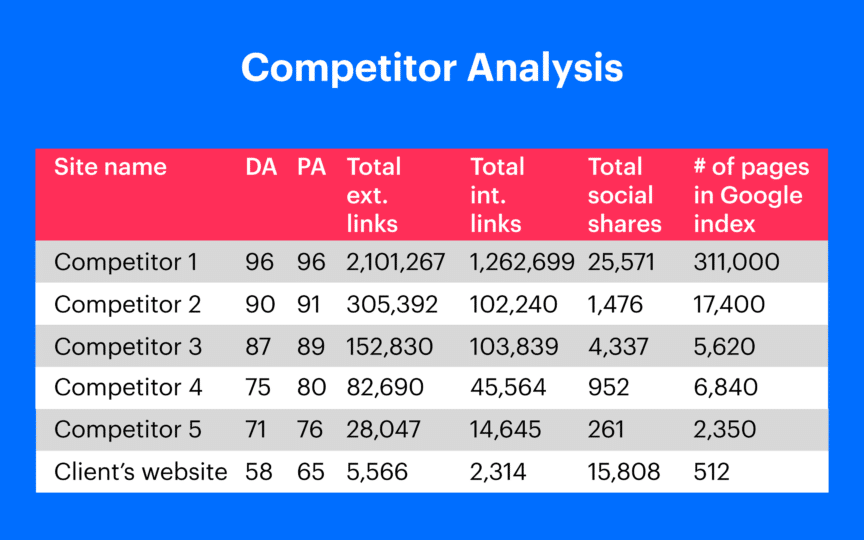
Others might be far more complex.
The most important thing is to make sure that you’re asking all the right questions.
If you don’t know what answers you’re looking for, then you won’t end up with any actionable data. In the case of the Moz competitor analysis example above, we can see that they’re looking for external links, social shares, and indexed pages. In a standard competitor analysis, you’d begin with much simpler information, such as:
- Who are your competitors?
- What are the services or products they offer?
- How much of a market share do they have?
- What are their current and past marketing strategies?
- What are their strengths and weaknesses?
A typical competitive analysis will cover a series of topics. Here, we’re going to show you a basic competitor analysis example that might apply to your current evaluation of any marketing efforts you might be involved with.

Item 1: Main competitors
When you’re putting together a list of your main competitors, there’s likely to be a few that instantly spring to mind as chief threats in your industry. These are the people that you’re battling against daily. However, it’s important to remember that there’s likely to be other people out there worth looking at too.
Your research should involve examining all of the companies that have an impact on your market share – including the little guys that might be targeting the same customers you’re looking at, with products that could replace what you’re selling. Get a complete view of the market and don’t leave anyone out.
Item 2: Services and products
Next, you’ll need to take a look at the details of your competitor’s products and services. Think carefully about any products that might be similar to your own, or have the potential to out-sell whatever you have to offer. While you’re researching, make sure that you consider any of the marketing plans that your competitors have in place to sell those products, and how they’re getting their name and branding out into the world.
Item 3&4: Strengths and weaknesses
Although it can be tempting to be overly critical of your competitors, it’s important to be brutally honest and objective when it comes to figuring out what other people are doing better, or worse than you. The report that you’re building becomes useless if you use bias in your judgement, and allow your beliefs to cloud reality.
This is a great time to start looking at your competitor analysis from the perspective of someone within the company. Think about what makes their products so great. Is it the quality? The cost of manufacturing? Do they have a great design? Make notes of everything that’s relevant.
Item 5: Strategies used
As part of your approach to good marketing, it’s crucial to ensure that you stay current with advertising and press releases. Doing this will help you to get a feel for how your competitors are telling their story to your target market.
The more you can learn about their strategies, the more you can begin to correlate different techniques with varying levels of success shown by the business. If you notice that certain techniques have better outcomes, then you can begin to make changes to your own methods that might help you to be more competitive in the future.
Item 6: Market position
Finally, to complete a really effective competitor analysis, you need a good overview of the market. Study the trends that are taking place in your industry, and find out what the customers who are buying your products, or the products of your competitors are looking for.
Look at your current position in the market, and find out whether any niches are emerging, or sub-categories that might help you to become more unique and appealing to your audience. By the time you get to this stage in our competitor analysis example, you should have plenty of information to inform your next strategy.
Delving deeper: Your competitor analysis template
Obviously, the competitor analysis example we’ve outlined above is just a basic insight into some of the information that you may need to gather about your biggest competitors. If you really want to make sure that you’re collecting actionable data that you can use to transform your company, then you might need to use a competitor analysis template with more depth.
Competitor analysis template examples can come in many different shapes and sizes, but they often include the following sections:
1. Profile and overview
This first section contains any of the basic information that you have about the business that you’re examining. Some useful details might include the size of their staff, their main value proposition, recent acquisitions, and the names of key staff members. The main piece of competitive information you should have in this segment is a description of the company’s position in relation to your own.
2. Competitive advantage
Once you know the basics about your competitor, you can begin to ask yourself the important questions. For instance, why would customers prefer to work with this competitor over you? What makes their services or products more compelling, and how do they stand out among other key players in the field? This section might be worth leaving until the end of your analysis, once you’ve already explored the target market of your competitors, their strategies, and their strengths and weaknesses.
Pro tip: One good way to figure out what another brand’s competitive advantage is, is to seek out information from customers through surveys and reviews.
3. The target market
Identifying a target market is a key part of any comprehensive competitor analysis template. Here, you’ll need to evaluate the kind of messaging that your competitor is using, and who they’re trying to communicate with. A good place to start researching your competitor’s market is to take a look at their story, their company manifesto, and other items of branding that you can use to distinguish the kind of people they’re trying to sell to.
If time permits, you should use the information you’ve gathered to create a couple of customer profiles. Doing this will allow you to determine whether your brand, and the competitor are attempting to capture the same client base.
4. The branding strategy
Looking at your competitor’s branding strategy means looking at how they position themselves in your chosen market. For instance, you might examine the message that they’re trying to share with their audience, or how they attempt to use their brand identity to leverage success through careful packaging, logos, and even content marketing.
Examining branding strategy means looking at what your competitors are doing both online, and offline, and whether they’re successful at communicating not only with their audience, but also with their internal staff, to create a consistent image.
5. Strengths and weaknesses
Understanding the strengths and weaknesses of your competitor is crucial, that’s why it makes up a standard part of any competitor analysis template. If you want to know how to improve your own branding strategies, and get rid of anything that might not work, then your best bet is to look at what’s having an impact for your competitors.
Additionally, pinpointing areas where your competitor might be weaker than you also gives you the chance to potentially swoop in on areas that they’ve left unprotected.
6. Opportunities and threats
Finally, once you’ve used your competitor analysis template to create customer profiles, look at branding strategies, and determine exactly what your competitors are doing to achieve success, you’ll be ready to start searching for threats and opportunities. This means narrowing your sights on companies that might pose a threat to your market position, and looking for opportunities to grow over brands that are weaker than you.
Once you narrow your evaluation down to your biggest competitors, you’ll be able to evaluate the weaknesses that they have, and see whether there might be an existing value proposition that you can use to draw their customers towards you instead. Here, you can figure out not only what you need to do to avoid losing customers, but also what you might be able to do to gain more.
Competitor analysis tools: Solutions to help
By this point, you’re probably thinking that competitor analysis is pretty complicated.
Although it’s no walk in the park, there are plenty of competitor analysis tools out there that can help you to gather some of the information that you might need to make strategic branding changes for your company.
Often, the tools that you might use to monitor your own position online and offline, could also help you to gather crucial information on your competition. For instance, some of the competitor analysis tools and resources that we like at Fabrik, include:
1. Google alerts
This is a simple, yet effective tool that can send actionable reports directly to your email inbox. If you’re looking for something that tells you every time a competitor is mentioned online, then you can achieve that with Google Alerts. You can also monitor keywords too!

Use this tool to:
- Monitor mentions
- Monitor keywords
- Check out competitor backlinks
2. Social mention
Today, most digital marketing campaigns come with some form of social media strategy. Social Mention is one of the competitor analysis tools that you can use to check out anything social. All you need to do is enter a search term, such as a company or keyword, and your tool will inform you of what’s being said across various platforms.
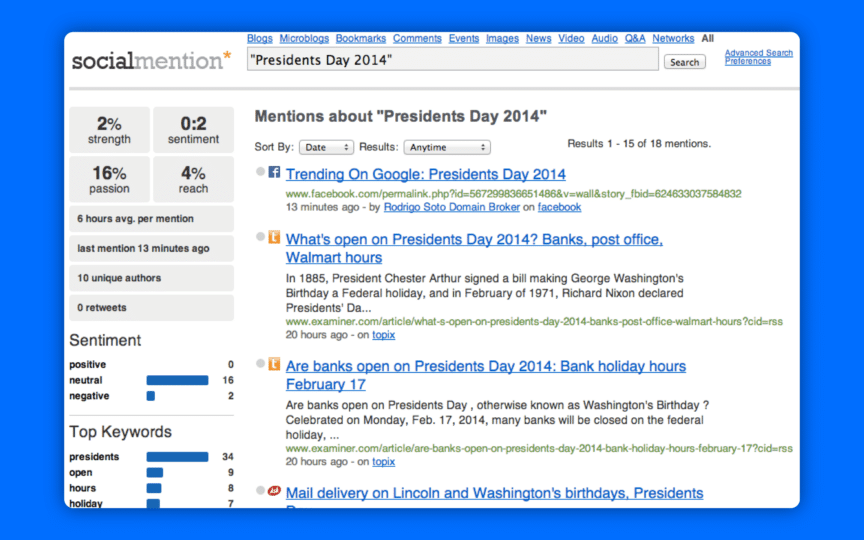
Use this tool to:
- Cross analyse conversations in different networks
- Monitor company mentions
- Track and monitor keyword mentions
3. SEMRush
This is one of the most popular competitor analysis tools out there because it’s all about offering useful competitor data. You can simply visit the homepage and type in the website of your competitor for free. You’ll immediately get all the information you need regarding keywords, rank, traffic, and ad-keywords, and it all comes to you in an easy-to-use format.
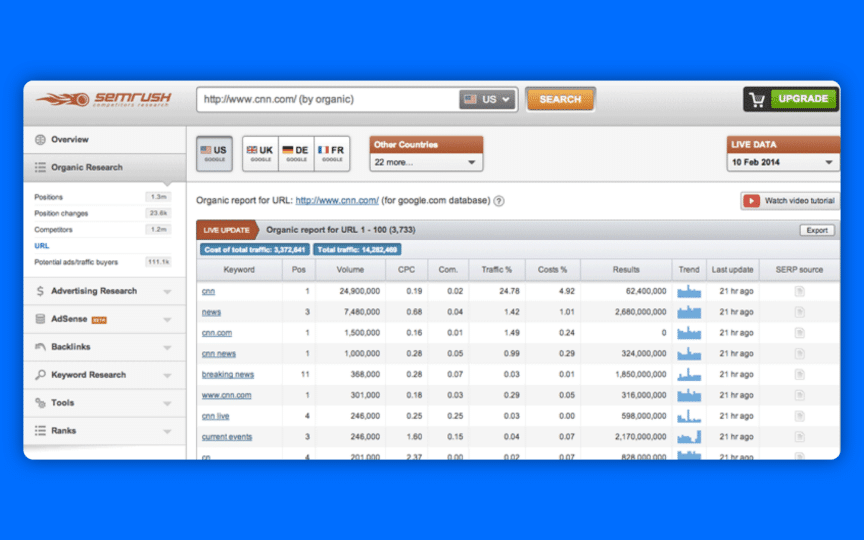
Use this tool to:
- Get keyword and traffic numbers for competitors
- Look at useful data
- Get organic ranks and keywords for competitors
4. SpyFu
SpyFu is a simple and effective tool that helps you to figure out which keywords your competitors are targeting. This is great if you want to run a social media or content campaign online to help you make your business more “digitally visible”. All you need to do is type in the details for your competitor, and you can download a complete list of their keywords.
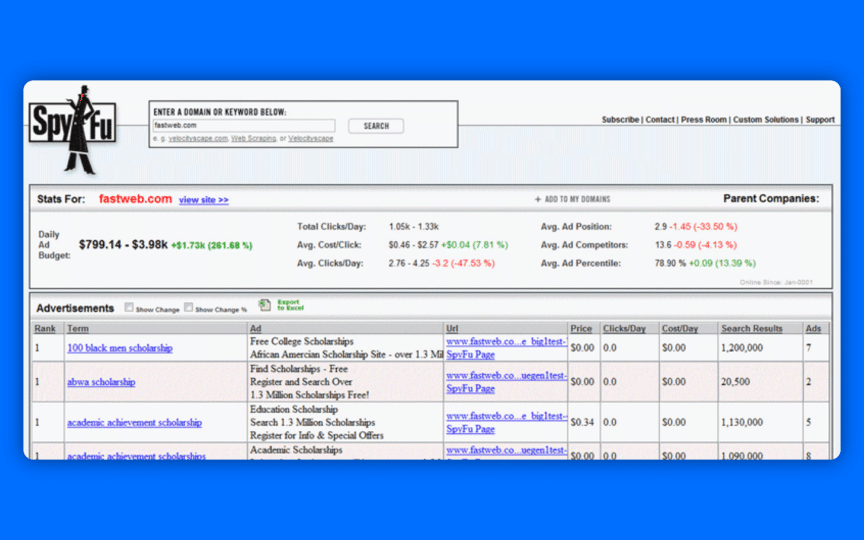
Use this tool to:
- Get a list of keywords your competitors are targeting with organic content
- Get a list of keywords your competitors are targeting with AdWords
5. Talkwalker Quick Search
Powerful search engine that compares the performance of brands online. With extensive coverage – social networks, news sites, blogs, forums – you can analyze conversations from the last 13 months to compare brand mentions, engagement, and sentiment in your industry.
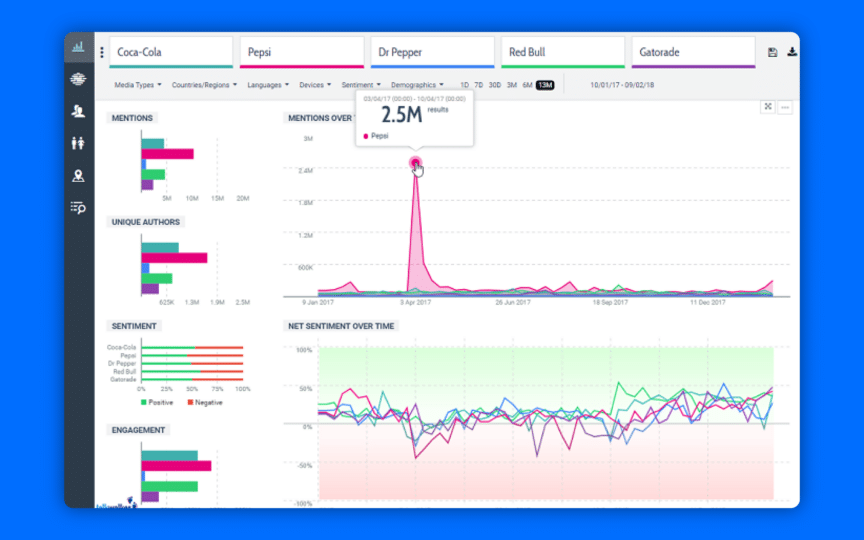
Use this tool to:
- Monitor sentiment with 90% accuracy
- Compare up to five brands simultaneously
- One-click influencer detection
6. Similar Web
Last but not least, this is one of the best competitor analysis tools for people who want to get an insight into the traffic for any website. All you need to do is type in a website and you’ll get an instant global rank, country rank, and category rank for that website, alongside a great graph that shows all the weekly visitors the company received during the last six months.
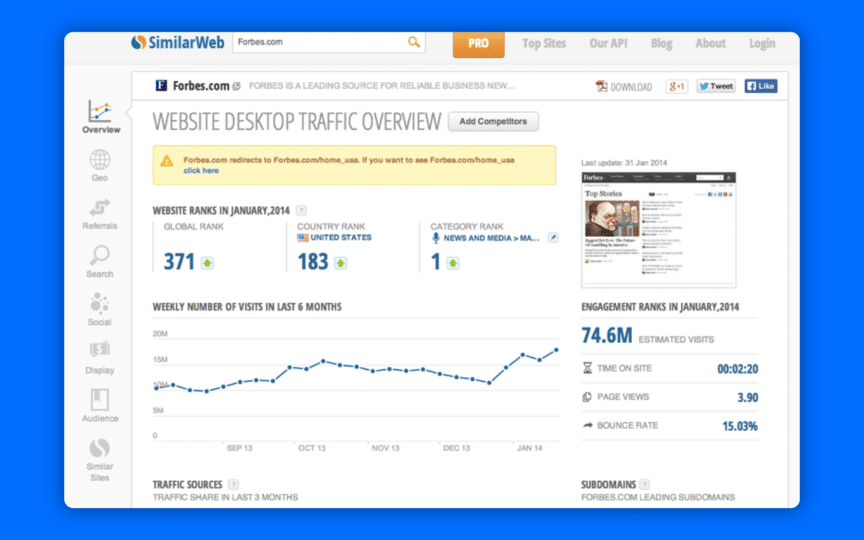
Use this tool to:
- Get comprehensive traffic insights
- Receive suggestions about competitors you might need to watch
The benefits of competitor analysis
At this stage, the chances are that you have a good idea of what competitor analysis is, and what you need to do to use it to your advantage. However, many people still believe that competitive analysis isn’t crucial, simply because they feel like they have a good idea of who their competition is, and what they’re offering.
The truth is that a great competitor analysis can help you to break into a new market, maintain your grip on an existing one, or simply give you the tools you need to better understand your audience. With a competitor analysis, you:
- Know where you stand: Are you the most popular business in your industry offering your specific services and products? If so, what makes you so popular? If not, what can you do to improve your position? Knowing how to brand yourself in relation to other competitors in your industry can ensure that you stand out from the crowd. Remember, no business exists in a vacuum, and it’s up to you to find out what your customers want.
- Identify opportunities: With a deep and comprehensive competitive audit, you can identify the low-hanging fruit in your industry, and gaps that you might be able to close in order to get more custom. You’ll know that starting a campaign on AdWords often works for people in your industry, or that people prefer to do business with companies that have more emotional back-stories. Whether you’re new to business, or you’re simply trying to stay ahead of the curve, competitive analysis gives you the information you need to keep growing your organisation.
- Remove threats: The chances are that you’ll notice specific gaps in your own company as you start to examine the strengths and weaknesses of other players in your market. If this is the case, then you’ll need to take steps to close those gaps and reduce the risks that you’re facing. Understanding why certain customers prefer your competitors to you can help you to re-think your branding strategies, improve your customer interactions, and offer an experience that’s more likely to appeal to your target market.
- Stay current: Finally, if you’re constantly tracking what your competitors are doing in your industry, then you become a student of your own market. You learn valuable new information and strategies all the time that will help you to grow and evolve. Eventually, if you rest on your laurels in any business, you’ll find you’ll fall behind smaller competitors that are more willing to change.
Competitive analysis can be a complicated thing for any business to come to terms with, but it’s also a valuable way to start making informed changes to your current strategy for branding, marketing and sales. Though you should never simply copy and paste what other people in your industry are doing, you can use their examples to inform your own decisions, and potentially take advantage of opportunities that you might not have spotted without a little competitive research.
Don’t be the business that’s left behind because you’re not willing to do your homework.
If you enjoyed this article, you might enjoy these too:
– How to write a brand positioning statement
– The value of cultivation corporate culture
– How to conduct a marketing audit and fix your communication woes











